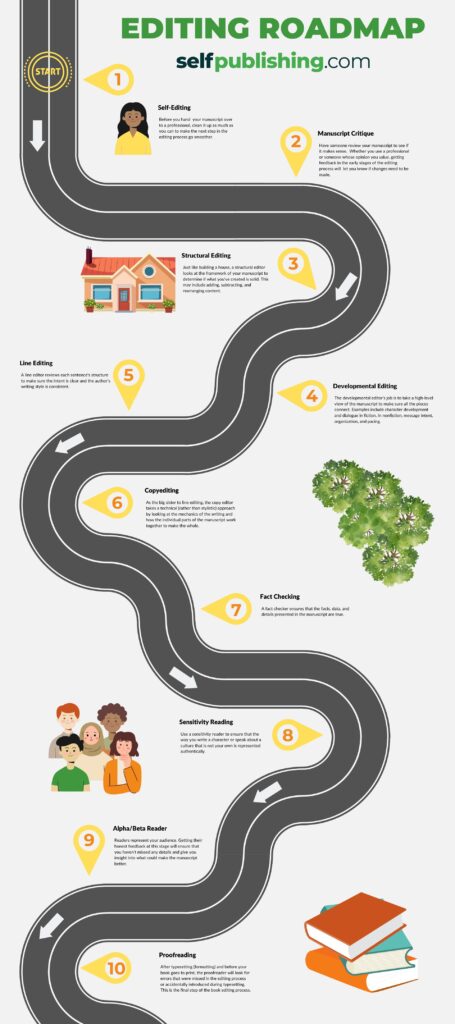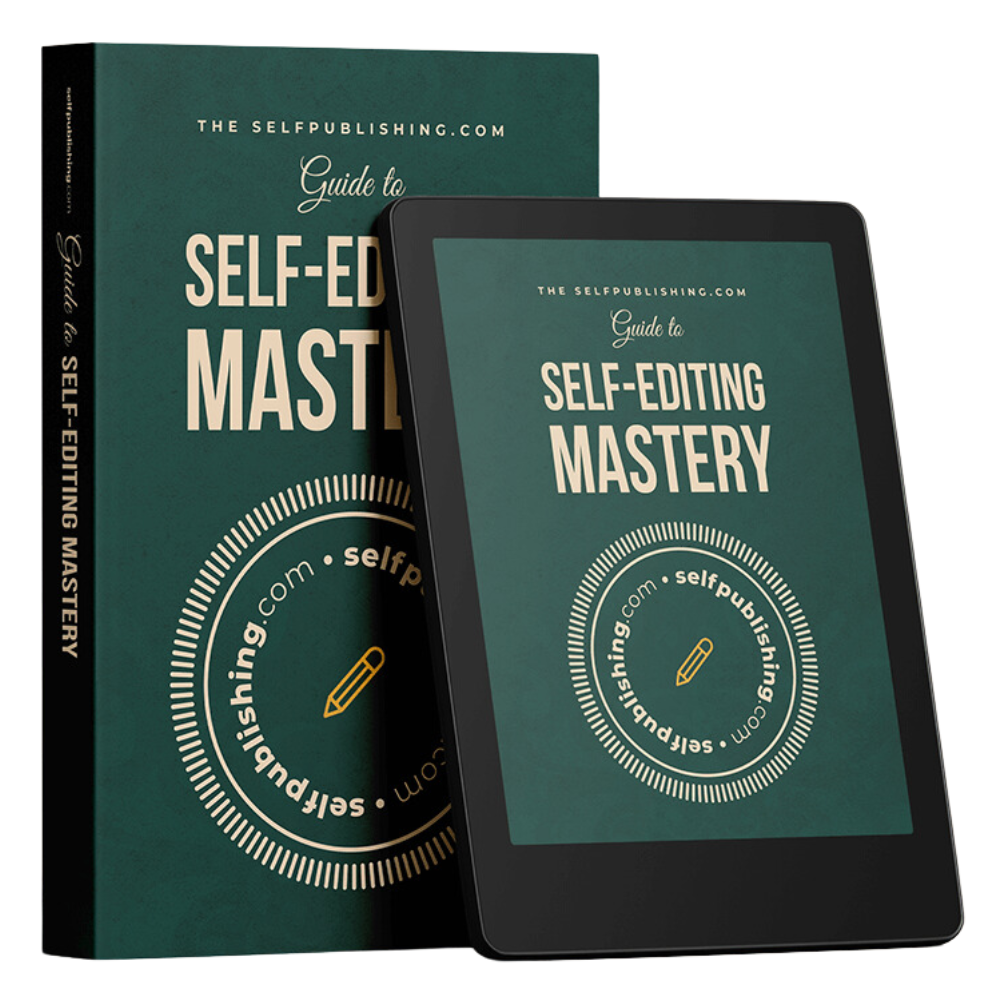So what is proofreading, exactly? Depending on who you ask, the meaning can change. Is it editing, nonediting, or something in between?
Let’s look at what proofreading is and how you can use it to ensure that you have the best book possible.
What is proofreading?
Traditionally, proofreading (also known as comparison proofing or blind proofing) comes at the end of the editing process after typesetting. It’s the final comb-through of the manuscript or book to ensure it is error-free.
Before digital print technology, manuscripts were typeset by hand using moveable type and metal plates. Proofreaders would receive a pre-production copy of the book called a galley proof or “galley” for short. The bound or loose-paged copy had wide margins for handwritten notes and didn’t always include all the front matter or proper pagination.
The proofreader’s job was to compare the typeset version to the copyedited version to see if new errors were introduced during typesetting or copy editing.
Here is an example of how moveable type works in printing. The video shows how easily errors can be introduced into the typesetting process.
Although typesetting errors are rare these days (since most typesetting is digital), proofreading is still an important part of the process. This person must analyze the manuscript with keen eyes to catch any mistakes that slipped through the cracks during the editing and revision processes. For this reason, proofreaders must be highly detailed and big-picture thinkers.
Why is proofreading important for my book?
After asking, “What is proofreading?” Many authors then ask us why it’s needed in their writing and publishing process.
The ultimate goal of any book editing is to create a polished product without errors. And most books undergo multiple rounds of editing.
Unfortunately, even the most rigorous editors can miss something.
Proofreading is the “just in case” pass-through to make sure nothing was missed. A proofreader’s job is to take an overhead and microscopic view of the entire book. Not only do they scan for small errors that slipped through the cracks, but they also look for larger problems missed during previous editing.
In Editing Fact and Fiction: A Concise Guide to Book Editing, the authors describe the original job of proofreaders in traditional publishing:
Among the proofreader’s many functions is to check for typographical errors (“typos”) after the manuscript has been typeset. This he does by reading galleys (preliminary typeset pages) or pages (final pages with illustrations, tables, footnotes, etc., in place) against the copyedited manuscript.
They go on to say,
The proofreader also reads words, sentences, and paragraphs as a copyeditor does: for correctness, consistency, and sense. If he has been given a style sheet provided by the copyeditor, he will check that the style points have been followed–for example, “spell out numbers under 10; healthcare (n. and adj.) but health food (n. and adj.).” If he is reading page proofs, he also checks the layout; this means among other things seeing that any illustrations or tables appear on or close to the page where they are discussed, that heads-including running heads–are correctly placed, and that there is the prescribed amount of space above or below them.
As you can see, a professional proofreader’s role goes beyond finding grammatical errors.
They are the gatekeepers, the final piece of the editing puzzle that puts an exclamation point at the end of the process.
In her book, The Book You Were Born to Write, author Kelly Notaras refers to proofreaders as the “quiet heroes of the publishing process.” This praise is well-deserved for the hardworking champions of a book’s final version.
Are there other types of book editing?
Yes!
In the three decades since Editing Fact and Fiction was written, some publishing circles have reframed the role of proofreading. Although proofreading and copy editing go hand in hand – even overlapping in many places – proofreading is seldom a stand-alone service or “basic edit.”
It’s just one part of the editing and revising process that helps you go from rough draft to published copy on your book launch day.
In reality, there are multiple different types of editing that you should know about as an author.

Depending on what type of genre or book you are writing, you may need different editing, such as developmental or line editing. If you are unsure of exactly what your manuscript needs, your book writing coach can advise you on the next steps – and may even be able to help you find a book editor or the right proofreader for the job!
Remember: A manuscript can potentially go through many hands during the editing process. When defining proofreading in its simplest form, think of it as a quality control setup to safeguard your end product.
When is the best time to proofread your manuscript?
The best time to proofread a manuscript is after typesetting.
At this point, the other rounds of editing and all revisions of your book should be complete. Now, the proofreader can look at the manuscript from an audience perspective.
This contrasts the first editor(s) – who sees the manuscript in its raw form.
How to hire a proofreader for your book
As an author, how do you know if a proofreader is up for the task?
Professional licensing and certifications are not required, so it’s important to look beyond the title or the services someone says they are offering. You will want to vet the person, review examples of their work, and interview them. Though it does require some time up front, this extra attention to detail can save you time, money, and unnecessary frustration in the future.
Remember that the ultimate goal is to get your book ready for publication. The proofreader you hire should have the verifiable experience and/or skills to make that happen.
Once again, your book writing coach or fellow authors could help you with the hiring process (this is one of the many benefits of having an author community!). Nothing beats a personal referral of someone who has worked with a great proofreader on their own book.
Regardless of how you find a proofreader, here are some questions to ask them before making the hire:
- Ask, “What is proofreading?” You want them to define their role and the services they offer in their own words.
- Ask them what proofreader services and/or other editing services they offer and see if they align with your expectations.
- Ask for references or books they have proofread. Locate the reviews on a platform like Amazon and read the lower-rated reviews to see if grammar or editing was an issue.
- Ask if they offer a sample service or if they can show a before and after of a previous one.
- Ask which style guide they use (e.g., APA, AP, Chicago Manual of Style).
- Ask how they prefer to add notes to the manuscript.
As with all editors, include questions about fees, turnaround times, and the number of revisions.
Finally, while an English or Journalism degree has value, it does not indicate the quality of proofreader’s skills. Go beyond the degree, website, and sales pitches.
Do you need qualifications to be a proofreader?
What if you want to become a proofreader?
We have many published authors who have asked us how to become a book editor or proofreader. This is a great way for authors to earn extra income and offer their own services. After all, you do have experience writing a book!
There are not a lot of requirements for becoming a proofreader, but it does vary depending on the field.
Academia and science-related fields often require a degree, but in the general market, proof of skills and experience is usually enough to get your foot in the door. If you are advertising your services on a platform or want to be associated with a company, you may need to complete a skills test to determine job fit.
Otherwise, most people will want to see a portfolio of work. We recommend adding a page for proofreading services (with examples) to your author website.
What are the best proofreading tools?
While it’s important to learn how to self-edit, here at SelfPublishing, we always advise our authors to use a professional editor and/or proofreader. This helps ensure the absolute best version of your book. After all, you put a lot of effort into writing your book, we want to make sure it’s as much of a success as possible!
However, we understand that budgets vary and hiring an expensive team of editors is not always feasible.
That’s one reason why we are such advocates for self-publishing your book!
And fortunately, there are many intuitive writing and editing software tools on the market that you can use to supplement your editing needs. The following tools offer the basics like grammar, tone, and punctuation fixes – even reading level scores. You can use them during the self-editing phase to streamline your editing and reduce unnecessary friction and delays.
You can also leverage the power of AI to give your manuscript a thorough edit. Our team has spent a lot of time trying to learn how best to do this. And we cover this topic in “Tips for Using an AI Editor for Your Book.”
The case for proofreading
Signing off on a manuscript before it takes flight is a heavyweight. So grab a professional proofreader and Dosey Doe!
Whether you are self-publishing or shopping your book to traditional publishers, proofreading is one of those steps in the editing process that you cannot afford to eliminate. It is the recipe card for your grandmother’s famous red velvet cake or the final inspection of your new home.
You can always wing it or take a shortcut, but is eliminating one of the most important steps really worth the risk?
We think not.
Remember that proofreading and editing are two sides of the same coin. Selecting a proofreader is a smart business decision for you and your book’s quality.

